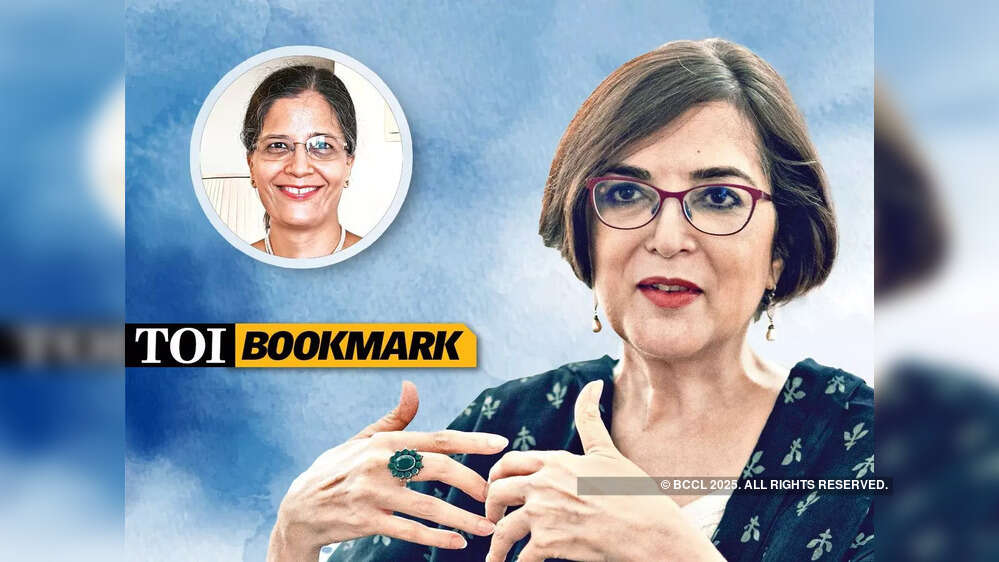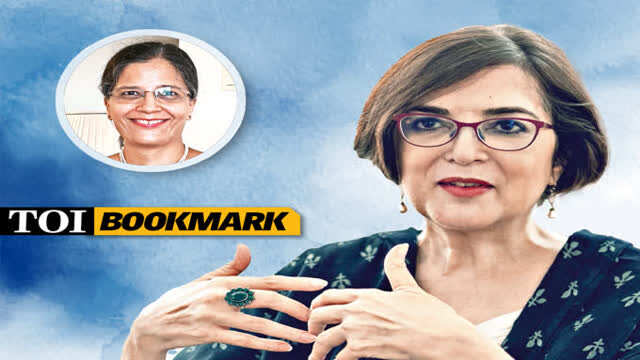How Joya Chatterji's 'Shadows At Noon' changes the notion of the history book
Joya Chatterji was the first woman director of Cambridge's Centre of South Asian Studies. For decades, she has made school curricula in Britain better reflect the country's history of migration. Shadows at Noon, her latest book, is fuelled by her passion to bring history to a larger reading public. In TOI Bookmark, a conversation about history and literature with the leading academic and writer.
Jaya Bhattacharji RoseTimes Network

EP1: How Joya Chatterji's 'Shadows At Noon' changes the notion of the history book
Joya Chatterjee, Emeritus Professor of South Asian History, University of Cambridge, Trinity College, Cambridge, has broken new ground across a range of fields in history. For these contributions, she was elected to the British Academy in 2018.
She has taught at the London School of Economics and then at Cambridge, supervising some 35 PhD students before illness led to her medical retirement. Elected to the Emeritus status at the Faculty of History at Cambridge and to Life Fellowship at Trinity, she continues to write.
Until her retirement in 2019, Joya had edited Modern Asian Studies, a leading journal in the field, and was the first woman to direct Cambridge's Centre of South Asian Studies.
Joya Chatterjee's engagement with public history has deep roots. Since the early 2000s, she has engaged in efforts to change school curricula across Britain to reflect the country's diverse history of migration. These have borne fruit.
Shadows At Noon, her latest book, is fuelled by her passion to bring history to a larger reading public.
“For me, the reader is someone who is working really hard to understand these processes and deserves my respect and shall have it,” she tells TOI Bookmark.
Joya lives in Cambridge with her husband. She has one son.
Jaya Bhattacharji Rose: We are here to discuss Shadows at Noon. Why don't you tell our listeners what it is all about, if you can?
Joya Chatterji: I can try. Shadows At Noon is a big book, but it does have an overarching theme. Or I would say two overarching themes. Both are comparative.
One is about the comparison between the British Raj era and what followed it. And the levels or degrees of change that came after the British packed up and left. And the areas of continuity and the many areas of change involved. So, it's that kind of book.
But to me, perhaps more interesting is the comparison. I say more interesting because this latter subject has been engaged in before. It's the comparison between India, Pakistan, Bangladesh within a single work.
And also the finding, to me quite mind boggling, that actually the differences between the three nations, first two and then later three nations, were not as wide as we've imagined or at least we've been led to imagine.
This is one of the big themes of the book.
And the other particularity of the book is its thematic structure, which means that it's not that you have to read the book start to finish. It starts in 1900 and you have a chapter that goes from 1900 to 1914, 1914 to 1932 or something like that. But every chapter is about something, whether it's about nationalism or about the household or about migration.
You read about each thing, each theme, as it unfurls over a century. And this means that a reader could, even though this is a big book, pick it up and look at one chapter, any chapter that took their fancy, and read it. And then perhaps jump to another chapter and read it and then maybe decide to go to the beginning. Because if you read it from the beginning, you will get less repetition.
But if you read it the other way as well, you might get the kind of knowledge you're looking for or the kind of stories you're looking for.
And that brings me to the third point about this book, that it is meant to be and is peopled with people…. I am a historian for my sins, but for a long time I've worked with anthropologists. And I have done a lot of life-history work in my time. So, this book is absolutely rich, I feel.
The best parts of the book, I feel, are the parts which are telling the stories which carry the book. So if there's a theme, say, of internal migration, it's carried by the story of a young woman who works on construction sites, who migrates again and again and again in order to in different life circumstances.
Or an illicit migrant to the UK or a migrant who is killed or dies, is almost killed in a car crash. And this helps to shift the balance of perspective from, if you like, from the teeming masses approach to a micro history approach where we understand individuals’ lives, each individual's life, as having turning points and tragedies and critical events to bringing them where they are.
And that helps us to understand that actually the South Asia is a world of migrants.
That's another point of the book. Essentially, 80% of South Asian people are migrants, internal migrants. And let's not forget the external migrants. So then there's this rather idiotic character, the author as a young child, nosy little girl who wanders around the book.
A lot of people have been intrigued by her presence in the book. Some people have questioned whether this is a book or a history book at all or whether it is a memoir. Of course, it's a work of history, as you will recognise if you read it. But what this little girl is doing is she's making it public history.
She's asking questions that you may have asked. She was a nosy little thing, and she never took much for granted. She always tried to understand. She believed that something like comprehension was possible. And, you know, she persisted in this goal of comprehension.
And that person was me. I mean, grew up to be me. This character, basically, is useful because at one level she could be the reader. She could be asking the question the reader might have had. She puts the reader and is or her in comprehension and puts herself on a par with the reader and say, look, I don't get it either. Let's explore this. It makes the reader perhaps feel at ease, and allows them into the history rather than shutting them out.
Does that help?
Maybe that's the way you're breaking the classical notion of a history book, by inserting yourself as a witness to the amount of history you've seen in your own space and have had the privilege of having learnt it as an academic discipline. So you bring that observation to play, as well.
That's true. I mean, I bring family history and life history and personal history as well, as I have done of many people. But I'm also interrogating the subject of history itself, which is a subject which has tended to write in a didactic, authoritative way.
Ever since the subject was born, it was written in this kind of QED kind of way. This is how it was, because, you know, source A says this, source B says this, etc. This book, by using this device of the child questioner, questions the whole mode in which the subject has been fashioned.
So, it's actually being a little bit of a pushback against the structure of the very subject. But, you know, I'm old enough to try to get away with this. And if historians are angry, which mostly they haven't been, it's okay.

EP2: Joya Chatterji: I really value the importance of public history in society
In Part 2 of the conversation, Joya says that she is a public historian. She values the importance of public history in society, but at the same time it is important to have a light touch in her writing. She also discusses the significance of the term, fact.
This is part two of a conversation with award-winning historian Joya Chatterjee. In part one, Joya Chatterjee speaks of her book Shadows At Noon. It is about the history of South Asia. It is also about life history. It straddles that space between memoir and history.
She's also interrogating the subject of history itself. This book, by using the device of the child questionnaire, questions the whole mode in which the subject has been fashioned. It is a bit of a pushback to the structure of this subject. She also discusses in detail why she wrote this fabulous book.
Jaya Bhattacharji Rose: Your knowledge sits lightly, Joya. It comes across as something, as somebody who's chatting and talking. And yet, as a reader, one has to pause because you realise how packed with information it is. Your touch is light.
Joya Chatterji: Well, I am a public historian. I want to be a public historian. I really value the importance of public history in society. So therefore, I think it's important to have a light touch. Because otherwise, what's the point of history if you just shut people out? With, you know, with jargon, with heaviness, with all of that.
So, I strove to keep it light. It was a big challenge. I mean, when you're so clobbered for yourself with acquiring all this newness and learning these new subjects and then to write it up. So that reader is protected from that your fatigue or your astonishment. I wanted to protect the reader and make the reader feel as if it was easy to read.
Because after all, that's the job.
You address the reader directly in some sections of the book. You know, you mentioned the reader, whoever that reader and ideal audience is. That's never clear, but that's OK. And so that is very interesting how you reach out across history, across this academic work in this style.
Yes, I do. And I would sometimes have arguments with my editor, a dear, sweet man, about this addressing of the reader, you know, particularly at and themes which were particularly bewildering.
Like, say, for instance, the colonial understanding of family law in India. And I would say things like reader, I expect you're getting overwhelmed. And he would get really, you know, ‘You're not really supposed to say reader.’ I said, ‘I know I'm not supposed to say a lot of these things I've said. I'm not supposed to say haven't and shan’t with, you know, but this is a different kind of approach to writing. So let me have a few reader moments where this poor reader is really having a pretty hard time with dealing with some really intricate things.’ If they don't sit with this, they owe it that I acknowledged them and their effort to stick with it.
So, for me, the reader is someone who is working really hard to understand these processes and deserves my respect and shall have it all the way.
For the full conversation, listen to the podcast
(Jaya Bhattacharji Rose, co-founder, Ace Literary Consulting and Associate Professor, School of Modern Media Studies, UPES University, has been associated with the publishing industry since the early 1990s)
Audio production: Sahil Gupta
Explore Every Corner
Across The Globe